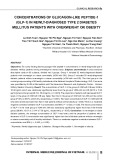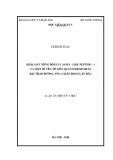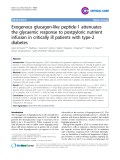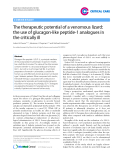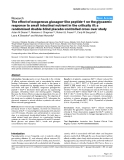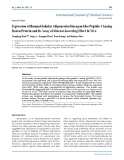
INTERNAL MEDECINE JOURNAL OF VIETNAM|NO 22/2021
13
CLINICAL RESEARCH
CONCENTRATIONS OF GLUCAGON-LIKE PEPTIDE-1
(GLP-1) IN NEWLY-DIAGNOSED TYPE 2 DIABETES
MELLITUS PATIENTS WITH OVERWEIGHT OR OBESITY
Le Dinh Tuan1, Nguyen Thi Phi Nga2, Nguyen Thi Tam3, Nguyen Tien Son2
Tran Thi Thanh Hoa3, Nguyen Thi Ho Lan3, Ngo Van Manh1, Le Duc Cuong1
Nguyen Thi Hien1, Vu Thanh Binh1, Nguyen Trung Kien1
1Thai Binh University of Medicine and Pharmacy, Thai Binh, Vietnam
2Military Hospital 103, Vietnam Military Medical University
3National Hospital of Endocrinology
ABSTRACT
Objectives: To survey fasting plasma glucagon-like peptide-1 concentrations in newly-diagnosed type 2
diabetes mellitus patients having overweight or obese status. Subjects and methods: A cross-sectional
descriptive study on 92 subjects, divided into 3 groups. Group 1 included 32 newly-diagnosed diabetic
patients with overweight or obese comorbidity (nDM with OB). Group 2 included 30 newly-diagnosed
diabetic patients without overweight or obese comorbidity (nDM with non-OB). The third group is the
control group consisting of 30 healthy individuals at the National Hospital of Endocrinology. GLP-1 hormone
was quantified by ELISA at Biomedical and Pharmaceutical Research and Application Center - Vietnam
Military Medical University. Result: The concentration of GLP-1 in the group of nDM with OB was 24.98 ±
10.36 pg/mL which was statistically significantly lower than the group of nDM with non-OB [32.15 ± 11.22
pg/mL] and control group [49.74 ± 18.24 pg/mL; p < 0.001]. The proportion of patients with decreased GLP-1
levels in the group of nDM with OB was higher than that in the group of nDM with non-OB and the control
group (71.9% vs 66.7% and 23.3%, respectively, p < 0.001). The mean concentration of GLP-1 in nDM with OB
who were central was lower than that in male patients without central obesity (p < 0.05). There is a moderate
negative correlation between GLP-1 concentration and BMI (r = - 0.433; p < 0.05). The mean concentration
of GLP-1 in the male group of nDM with OB was statistically significantly higher than that of the female
group (28.99 ± 12.01 vs. 21.44 ± 7.30 pg/mL, respectively, p < 0.05). Conclusion: In overweight or obese
diabetic patients, the average concentration of GLP-1 was lower, and the proportion of patients with a
decrease in GLP-1 concentration was significantly higher than that of diabetic patients without overweight
or obese comorbidity and of healthy individuals. There is a moderate negative correlation between GLP-1
concentration and BMI (r = -0.433; p < 0.05).
* Keywords: Newly-diagnosed type 2 diabetes; Glucagon-like peptide-1; Overweight or obesity.
Corresponding author: Nguyen Thi Phi Nga (ngabv103@yahoo.com.vn)
Date received: 10/5/2021
Date accepted: 01/6/2021





